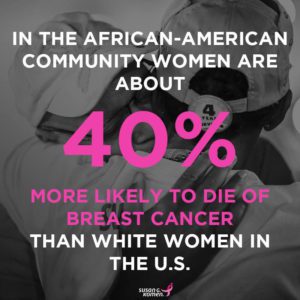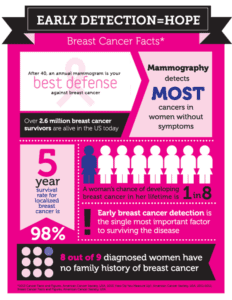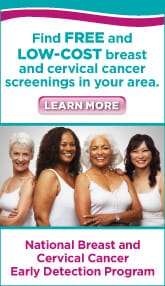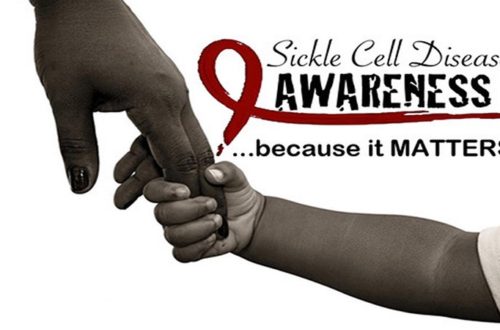
October: National Breast cancer Awareness Month
Breast cancer is one of the most common cancers affecting American women. Currently, the average risk of a woman in the United States developing breast cancer sometime in her life is about 12%. While breast cancer is most commonly found in women, it can affect men as well.
Breast cancer is a disease in which cells in the breast grow out of control. These cells are cancerous if they can grow into (invade) surrounding tissues or spread(metastasize) to distant areas of the body. The kind of breast cancer a person has depends on which cells in the breast turn into cancer.
Did you know:

- Among women ages 40 to 50, African-American women have a higher incidence of breast cancer than white women
- African-American women also have the highest death
rate from breast cancer
- The higher death rate has been linked to the stage, or extent, of the cancer at diagnosis
- African-American women tend to seek treatment when their cancer is in a more advanced, less treatable stage.
Risk Factors:
Some risk factors for breast cancer are things you cannot change. These risks include:
- Female gender
- Getting older
- Inheriting certain gene changes (BRCA1 or BRCA2 gene – most common)
- Having a family history of breast cancer
- Having a personal history of breast cancer
- Race
- Starting your period before age 12
- Starting menopause after 55
- Exposure to DES (diethylstilbestrol) between 1940-1960
- Having dense breast
- Previous treatment using radiation
Breast cancer risk factors that can be changed:
- Exposure radiation
- Being obese
- Physical inactivity
- Alcohol consumption
- Exposure to hormones (the pill IVF, HRT)
- First pregnancy after age 30
- Not breastfeeding
Signs & Symptoms:
The most common symptom:
- A new lump or
mass
- These masses are usually painless, hard, and have irregular edges
- These masses can be tender, soft, rounded or painful as well
Other possible symptoms:
- Swelling of all or part of a breast (even if no distinct lump is felt)
- Skin irritation or dimpling (sometimes looking like an orange peel)
- Breast or nipple pain
- Nipples turning inward
- Redness, scaliness, or thickening of the nipple or breast skin
- Nipple discharge (other than breast milk)
Prevention:
Although breast cancer screening cannot prevent breast cancer, it can help find breast cancer early, when it is easier to treat. Talk to your doctor about which breast cancer screening tests are right for you, and when you should have them.
Breast Cancer Screening Tests

- Mammogram – At this time, a mammogram is the best way to find breast cancer for most women
- Breast Magnetic Resonance Imaging (MRI) – used along with mammograms to screen women who are at high risk for getting breast cancer.
- Clinical Breast Exam – an examination by a doctor or nurse, who uses his or her hands to feel for lumps or other changes.
- Breast Self-Awareness – being familiar with how your breasts look and feel can help you notice symptoms such as lumps, pain, or changes in size that may be of concern.
*Having a clinical breast exam or doing a breast self-exam has not been found to lower the risk of dying from breast cancer.
Healthy bodies are beautiful bodies. Please take the time to be aware of the different issues that may affect you and make a conscious effort to prevent them. For more information please visit The American Cancer Society’s website





